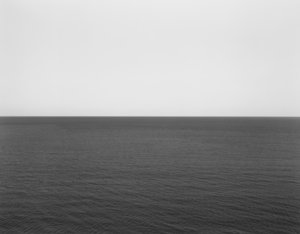 |
| Hiroshi Sugimoto Surface Tension installation @ Marian Goodman Gallery |
Standing in Marian Goodman's Marais Gallery for Sugimoto's Surface Tension exhibition, we forget we are in darkness because the light
emanating from the photographs (as well as the spotlights shining on them)
makes the space luminescent. It’s as difficult to describe the endless
fascination of these photographs of a single subject as it is to explain how
photographs in the dark can give off the impression of being in a light filled
room. So you will have to believe me when I say that this exhibition is a never-ending
narrative of surprise.
 |
| Hiroshi Sugimoto Surface Tension installation @ Marian Goodman Gallery |
Seeing this many of Sugimoto’s seascape photographs together in one space changes everything. It changes the way that we look at his photography, it changes the way that we see the world, it changes the way that we understand photography. These photographs of seascapes in which the sky can be a leaden black weight on a fragile sea, or sea and sky can be indistinguishable expanses of white, open up everything we thought we knew about the sea. I even suspect this might be one of those exhibitions that change our expectations of what art does.
 |
| Hiroshi Sugimoto Surface Tension installation @ Marian Goodman Gallery |
So what do we see? It’s the same image over and over again of the sea, the sky and the horizon line shot over time at different locations around the world over a number of years. The form of the image is always the same with the horizon running exactly midway through the photographic composition. Sugimoto photographs every sea across the world; the Pacific Ocean, the Celtic Sea, the Tasman Sea, the Sagami Sea and the Aegean Sea being some of those pictured in the exhibition. And although it's always the sea, each sea and each image is also different. What we see is the sea in its infinity, proliferating and reaching into infinity, endlessly transformed by the weather, the light, the location and from photograph to photograph in the exhibition. The sea is never the same, ever. Sugimoto’s form of repetition that never repeats pushes the photograph to its limits of abstraction. Over time with these images it doesn’t matter where they are taken because they tell nothing of the place itself. They become self-enclosed abstract worlds of their own that refer only to the sea in another abstract, unlocatable place.
 |
| Hiroshi Sugimoto Surface Tension installation @ Marian Goodman Gallery |
Sugimoto’s seascapes draw our attention to the horizon as the most mysterious and enigmatic of “objects” or phenomena. It can be a clearly defined line between sky and sea, or erased by the haze of the air, but whichever form it takes, the human eye is unable to see and to hold the line of the horizon. And because Sugimoto has removed all familiar markers – perhaps a gull in the sky, a cloud passing by, a ship, or even waves on the ocean — means that we have no access to the sea, the sky and the horizon. Nothing on either side of the horizon helps us to grasp what is in the image. We are left with wild and overwhelming visions of a phenomenon that cannot be controlled or ever fully understood by our eye. In this sense, photography would seem to be the exact wrong medium to capture the sea. Because the sea is constantly evading the eye, even that of the camera, while photography wears its capacity to capture on its surface.
 |
| Hiroshi Sugimoto, Carribian Sea Jamaica, 1980 |
It’s not just photography that is challenged in the seascapes; indeed, one might argue that, Sugimoto is doing the work of contemporary painting. The photographs over time are less about photography than they become a struggle or negotiation with the questions of painting – texture, tone, hue, light and the unreliability of vision. The sea has fascinated painters throughout history, and particularly in modern times. From Casper David Friedrich’s distant, ethereal bodies of water to the churned-up emotions of J M W Turner’s stormy seas, painters have sought to explore their age and their medium through depictions of the sea. In its multiple and infinite variations, in the light of the moon, the sun, under clouds, in rain, at night and during the day, Sugimoto’s manipulated seas start to bear the brushstrokes of painting. I am not the first to see Rothko in these seas, and indeed, the connections to late 20th century abstract painting are everywhere. The concerns of Sugimoto’s seascapes are the same as those of his colleagues working in paint. To give one example, the horizon is always dead centre, but it appears to be in different places depending on the light during the day or night, the weather, the latitude and longitude of the location. Thus, the images become also about optical illusion, the forces on our vision, and our resultant willingness to submit to the manipulation of the image (and the sea). Accordingly, we might say that the sea in Sugimoto’s photographs comes to teach us even more than can be imagined. We even learn about our own limitations, particularly, the limitations of our physical vision, but also, our willingness to be deceived by an illusion.





No comments:
Post a Comment